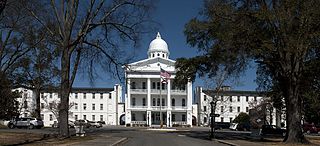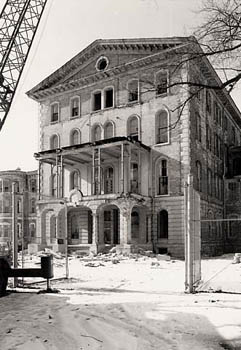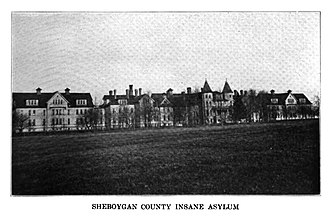
Sheboygan County is a county in the U.S. state of Wisconsin. It is named after the Sheboygan River. As of the 2020 census, the population was 118,034. Its county seat is Sheboygan. The county was created in 1836 and organized in 1846. At the time, it was located in the Wisconsin Territory. Sheboygan County comprises the Sheboygan, WI Metropolitan Statistical Area. Part of the Holyland region is located in northwestern Sheboygan County.

Tewksbury Hospital is a National Register of Historic Places-listed site located on an 800+ acre campus in Tewksbury, Massachusetts. The centerpiece of the hospital campus is the 1894 Richard Morris Building.

Austin State Hospital (ASH), formerly known until 1925 as the Texas State Lunatic Asylum, is a 299-bed psychiatric hospital located in Austin, Texas. It is the oldest psychiatric facility in the state of Texas, and the oldest continuously operating west of the Mississippi River. It is operated by the Texas Health and Human Services Commission.

Bryce Hospital opened in 1861 in Tuscaloosa, Alabama, United States. It is Alabama's oldest and largest inpatient psychiatric facility. First known as the Alabama State Hospital for the Insane and later as the Alabama Insane Hospital, the building is considered an architectural model. The hospital houses 268 beds for acute care, treatment and rehabilitation of full-time (committed) patients. The Mary Starke Harper Geriatric Psychiatry Hospital, a separate facility on the same campus, provides an additional 100 beds for inpatient geriatric care. The main facility was added to the National Register of Historic Places in 1977.

Whitby Psychiatric Hospital, also known as Whitby Psych, Ontario Hospital for the Insane, Ontario Hospital, Whitby, or OHW, is a mental health facility located in Whitby, Ontario. A modern hospital replaced the cottage campus in 1996. The hospital later renamed to Ontario Shores Centre for Mental Health Sciences, which operates on the same site.

Agnews Developmental Center were two psychiatric and medical care facilities, located in Santa Clara, California and San Jose, California respectively.

Georgia's state mental asylum located in Milledgeville, Georgia, now known as the Central State Hospital (CSH), has been the state's largest facility for treatment of mental illness and developmental disabilities. In continuous operation since accepting its first patient in December 1842, the hospital was founded as the Georgia State Lunatic, Idiot, and Epileptic Asylum, and was also known as the Georgia State Sanitarium and Milledgeville State Hospital during its long history. By the 1960s the facility had grown into the largest mental hospital in the world. Its landmark Powell Building and the vast, abandoned 1929 Jones Building stand among some 200 buildings on two thousand acres that once housed nearly 12,000 patients.
The Essex County Hospital Center, also known as the Overbrook Hospital, the Overbrook Asylum, or simply the Overbrook, was a psychiatric hospital that was located around 125 Fairview Avenue in the Township of Cedar Grove, New Jersey. It was used as a general hospital then converted to house patients with mental disorders. The original hospital was located at the edge of the Hilltop Reservation and designated a Conservation Easement in 2001 by the New Jersey Department of Environmental Protection; the site now is part of the Essex County park system. A new hospital opened in 2006, and the site of the original hospital was converted to a park and townhomes in 2017.

The Rosewood Center was an institution for people with developmental disabilities located on Rosewood Lane in Owings Mills, Maryland.

Mendota Mental Health Institute (MMHI) is a public psychiatric hospital in Madison, Wisconsin, United States, operated by the Wisconsin Department of Health Services. The hospital is accredited by the Joint Commission. Portions of the facility are included in the Wisconsin Memorial Hospital Historic District, District #88002183. The Mendota State Hospital Mound Group and Farwell's Point Mound Group are also located at the facility.

Cherry Hospital is an inpatient regional referral psychiatric hospital located in Goldsboro, North Carolina, United States. As one of three psychiatric hospitals operated by the North Carolina Department of Health and Human Services, it provides services to 38 counties in the eastern region of North Carolina. It is part of the Division of State Operated Healthcare Facilities within the Department of Health and Human Services, which oversees and manages 14 state-operated healthcare facilities that treat adults and children with mental illness, developmental disabilities, and substance use disorders. The Division's psychiatric hospitals provide comprehensive inpatient mental health services to people with psychiatric illness who cannot be safely treated at a lower level of care.

The Elgin Mental Health Center is a mental health facility operated by the State of Illinois in Elgin, Illinois. Throughout its history, Elgin's mission has changed. At times, it treated mental illness, tuberculosis, and provided federally funded care for veterans. The hospital's site, which included a patient-staffed farm reached a maximum of 1,139 acres (461 ha) after World War II. Its maximum population was reached in the mid 1950s with 7,700 patients. Between 1993 and 2008, most of the older buildings in the complex were demolished due to being in poor condition as the result of being abandoned for decades. The site is/was popular among teens and in the paranormal world due to its claims of hauntings in the older buildings and the hospital's cemetery.
The Jacksonville Developmental Center was an institution for developmentally delayed clients, located in Jacksonville, Illinois. It was open from 1851 to November 2012. As of December 2012, the 134-acre (54 ha) grounds was still owned by the State of Illinois.

Winnebago Mental Health Institute (WMHI), formerly the Winnebago State Hospital, is a psychiatric hospital near Oshkosh, Wisconsin, United States located in the unincorporated community of Winnebago, Wisconsin.

The Norfolk Regional Center is a psychiatric hospital located in Norfolk, Nebraska. It is one of three regional centers operated by the Nebraska Department of Health and Human Services.

Stockton State Hospital or the Stockton Developmental Center was California's first psychiatric hospital. The hospital opened in 1851 in Stockton, California, United States, and closed 1995–1996. The site is currently used as the Stockton campus of California State University, Stanislaus.
Eastern State Hospital, located in Lexington, Kentucky, is the second oldest Psychiatric Hospital in the United States. It operates today as a psychiatric hospital with 239 beds providing inpatient care. Eastern State Hospital is owned by the Commonwealth of Kentucky, operated by the University of Kentucky's UK HealthCare and falls under the jurisdiction of the Cabinet for Health and Family Services.

Outagamie County Health Center, established in 1889, was a psychiatric hospital serving Outagamie County, Wisconsin. It was first named Outagamie County Asylum for the Chronic Insane, then Outagamie County Hospital, and finally Outagamie County Health Center.

The Racine County Insane Asylum was a mental hospital, operated by the County of Racine, Wisconsin, from 1889 to the 1970s.

Arkansas State Hospital, originally known as Arkansas Lunatic Asylum, is the sole public psychiatric hospital in the state of Arkansas, and is located in the city of Little Rock. It was established in 1883 and as of 2023, it is still active. Its main focus is on acute care rather than chronic illness.



















